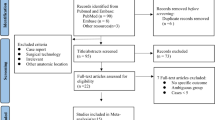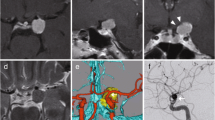Abstract
Introduction
Literature specifically focusing on clinoidal meningiomas is scant, particularly with regards to the postoperative visual outcome. In this study, we aimed to document the incidence of optic canal involvement (OCI) by the tumor, its management using a skull base technique, and its significance with relation to the visual outcome.
Materials and methods
Fifty-two patients with clinoidal meningiomas were retrospectively analyzed. In 47 patients, skull base technique consisting of extradural anterior clinoidectomy with falciform ligament and optic nerve sheath opening was performed. Pre-operative visual status and post-operative outcome were analyzed with respect to OCI.
Results
The incidences of OCI was present in 19 (36%) and pre-operative visual deficit (VD) in 24 (46%) patients. With regard to pre-operative visual status, OCI was seen in 14 (58%) of 24 patients with VD, as compared to five (18%) in 28 patients without (p = 0.004). Among the 22 patients with VD and detailed postoperative neuro-ophthalmological evaluation, 17 (77%) had visual improvement, and in five patients (23%), vision was unchanged. In the presence of OCI in 11 patients, vision improved in seven (64%), and remained unchanged in four patients (36%), whereas all but one of the 11 patients (91%) without OCI improved and in the remaining one (9%), remained unchanged. Simpson Grade I and II resection was achieved in 71%.
Conclusion
OCI is observed in 36% of clinoidal meningiomas, and it correlates well with pre-operative visual status. With the use of the skull base technique, without which the tumor in the optic canal could not have been removed completely and safely, visual improvement of 77% and stability of 23% was achieved.



Similar content being viewed by others
References
Al-Mefty O, Ayoubi S (1991) Clinoidal meningiomas. Acta Neurochir Suppl 53:92–97
Andrews BT, Wilson CB (1988) Supraselar meningiomas: the effect of tumor location on postoperative visual outcome. J Neurosurg 69:523–528
Dolenc V (1983) Direct microsurgical repair of intracavernous vascular lesions. J Neurosurg 58:824–831
Evans JJ, Hwang YS, Lee JH (2000) Pre- versus post-anterior clinoidectomy measurments of the optic nerve, internal carotid artery, and opticocarotid triangle: a cadaveric morphometric study. Neurosurgery 46:1018–1023
Goel A, Gupta S, Desai K (2000) New grading system to predict respectability of anterior clinoid meningiomas. Neurol Med Chir (Tokyo) 40:610–617
Klink DF, Sampath P, Miller NR, Brem H, Long DM (2000) Long-term visual outcome after nonradical microsurgery in patients with parasellar and cavernous sinus meningiomas. Neurosurgery 47:24–32
Lee JH, Jeun SS, Evans J, Kosmorsky G (2001) Surgical management of clinoidal meningiomas. Neurosurgery 48:1012–1021
Lee JH, Sade B, Park BJ (2006) A surgical technique for the removal of clinoidal meningiomas. Neurosurgery 59(ONS Suppl 1):108–114
Maniscalco JE, Habal MB (1978) Microanatomy of the optic canal. J Neurosurg 48:402–406
Margalit NS, Lesser JB, Moche J, Sen C (2003) Meningiomas involving the optic nerve: Technical aspects and outcomes in 50 patients. Neurosurgery 53:523–533
Nakamura M, Roser F, Jacobs C, Vorkapic P, Samii M (2006) Medial sphenoid wing meningiomas: clinical outcome and recurrence rate. Neurosurgery 58:626–639
Puzilli F, Riggeri A, Mastronardi L, Agrillo A, Ferrante L (1999) Anterior clinoidal meningiomas: report of a series of 33 patients operated on through pterional approach. Neuro-oncology 1:188–195
Risi P, Uske A, de Tribolet N (1994) Meningiomas involving the anterior clinoid process. Br J Neurosurg 8:295–305
Rosenstein J, Symon L (1984) Surgical management of suprasellar meningioma: Part 2: Prognosis for visual function following craniotomy. J Neurosurg 61:642–648
Sade B, Kweon CY, Evans JJ, Lee JH (2005) Enhanced exposure of carotico-oculomotor triangle following extradural anterior clinoidectomy: A comparative anatomical study. Skull Base 15:157–162
Tobias S, Kim CH, Kosmorsky G, Lee JH (2003) Management of surgical clinoidal meningiomas. Neurosurg Focus 14(6):e5
Yonekawa Y, Ogata N, Imhof HG, Olivecrona M, Strommer K, Kwak TE, Roth P, Groscurth P (1997) Selective extradural anterior clinoidecomy for supra- and parasellar processes. J Neurosurg 87:636–642
Zevgaridis D, Medele RJ, Muller A, Hischa AC, Steiger HJ (2001) Meningiomas of the sellar region presenting with visual impairment: Impact of various prognostic factors on surgical outcome in 62 patients. Acta Neurochir (Wien) 143:471–476
Acknowledgements
This study was presented in part at the 75th Annual Meeting of the American Association of Neurological Surgeons in Washington, DC on April 17, 2007, and received the Synthes Skull Base Award.
Author information
Authors and Affiliations
Corresponding author
Additional information
Comment
This is an extension of previously published data on the issue of clinoidal menigiomas. Nonetheless, the information and discussion drawn from this considerable sample with regard to optic canal involvement and clinoidal hyperostosis are interesting for the reader of Acta Neurochirurgica.
H.-.J Steiger
University of Dusseldorf
Comment
In this article the authors report a retrospective series of 52 patients operated for clinoid meningioma. The emphasis is on the involvement of the optic nerve and the visual outcome after surgery. Burak et al. exclude other meningiomas from the “parasellar” region like tuberculum sella and sphenoid wing meningioma a factor which makes the group of patients more homogenous. I agree with the technique of drilling the optic canal and decompressing the optic nerve. Not only does it help identify the normal anatomy in an early stage of tumor resection, but it also allows the manipulation of the nerve with less damage.
Like the authors, I also find it hard to predict the involvement of the optic canal based on the preoperative MRI and CT.
The weak point of the study is the number of patients that actually had a detailed visual exam before and after surgery. There were only 22 out of the 52 patients in the series who had the complete visual exam, without which it is hard to interpret the results of the visual status of the patients as a result of surgery.
Nevo Margalit
Tel Aviv Medical Center
Comment
We agree with the authors that the skull base technique described in this article allows for the early identification and decompression of the optic nerve as well as early identification of the carotid artery. The opening of the optic canal and the removal of intracanalicular extensions of the tumor creates the best conditions for visual improvement. We have used the same technique in over 80 patients and obtained similar results. The presence of temporary postoperative oculomotor palsy in 10% of the patients is related to the proximity of the nerve to the anterior clinoid process when coursing through the superior orbital fissure. Careful drilling and copious irrigation should avoid this serious complication.
Felix Umansky
Hadassah Hebrew University Medical Center
Jerusalem, Israel
Rights and permissions
About this article
Cite this article
Sade, B., Lee, J.H. High incidence of optic canal involvement in clinoidal meningiomas: rationale for aggressive skull base approach. Acta Neurochir (Wien) 150, 1127–1132 (2008). https://doi.org/10.1007/s00701-008-0143-y
Received:
Accepted:
Published:
Issue Date:
DOI: https://doi.org/10.1007/s00701-008-0143-y




